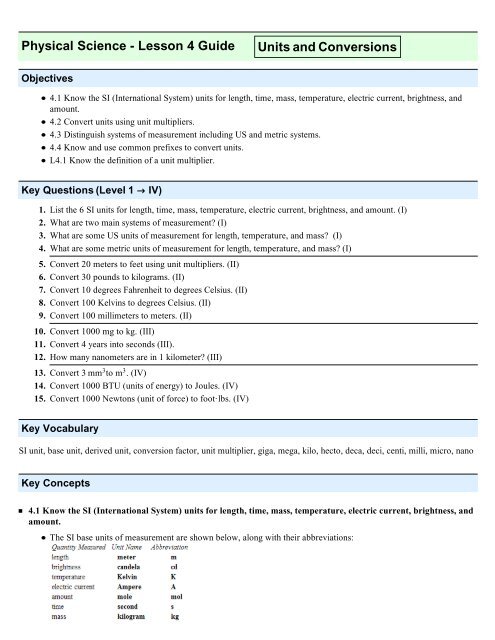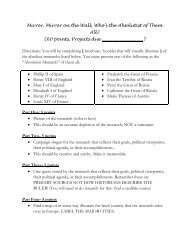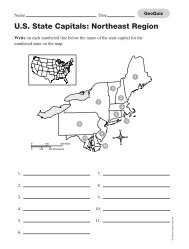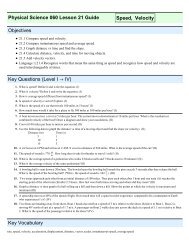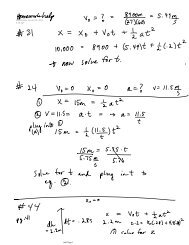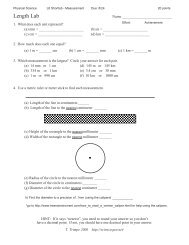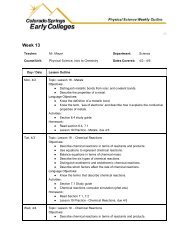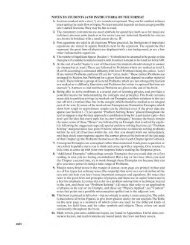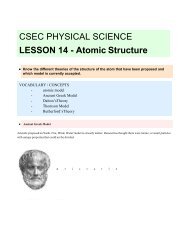Physical Science - Lesson 4 Guide Units and Conversions
Physical Science - Lesson 4 Guide Units and Conversions
Physical Science - Lesson 4 Guide Units and Conversions
Create successful ePaper yourself
Turn your PDF publications into a flip-book with our unique Google optimized e-Paper software.
<strong>Physical</strong> <strong>Science</strong> - <strong>Lesson</strong> 4 <strong>Guide</strong><strong>Units</strong> <strong>and</strong> <strong>Conversions</strong>Objectives• 4.1 Know the SI (International System) units for length, time, mass, temperature, electric current, brightness, <strong>and</strong>amount.• 4.2 Convert units using unit multipliers.• 4.3 Distinguish systems of measurement including US <strong>and</strong> metric systems.• 4.4 Know <strong>and</strong> use common prefixes to convert units.• L4.1 Know the definition of a unit multiplier.Key Questions (Level 1 IV)1. List the 6 SI units for length, time, mass, temperature, electric current, brightness, <strong>and</strong> amount. (I)2. What are two main systems of measurement? (I)3. What are some US units of measurement for length, temperature, <strong>and</strong> mass? (I)4. What are some metric units of measurement for length, temperature, <strong>and</strong> mass? (I)5. Convert 20 meters to feet using unit multipliers. (II)6. Convert 30 pounds to kilograms. (II)7. Convert 10 degrees Fahrenheit to degrees Celsius. (II)8. Convert 100 Kelvins to degrees Celsius. (II)9. Convert 100 millimeters to meters. (II)10. Convert 1000 mg to kg. (III)11. Convert 4 years into seconds (III).12. How many nanometers are in 1 kilometer? (III)13. Convert 3 mm 3 to m 3 . (IV)14. Convert 1000 BTU (units of energy) to Joules. (IV)15. Convert 1000 Newtons (unit of force) to foot·lbs. (IV)Key VocabularySI unit, base unit, derived unit, conversion factor, unit multiplier, giga, mega, kilo, hecto, deca, deci, centi, milli, micro, nanoKey Concepts 4.1 Know the SI (International System) units for length, time, mass, temperature, electric current, brightness, <strong>and</strong>amount.• The SI base units of measurement are shown below, along with their abbreviations:
2 physci_guide04_units_conversions.nb 4.2 Convert units using unit multipliers.• Unit multipliers are equivalent units written as fractions. When multiplied, they convert one unit to another.• Examples of unit multipliers:1 m 100 cm<strong>and</strong>100 cm 1 m• Converting 10 miles to meters:10 mi1 1600 m1 mi⩵ 16, 000 meters• The most important unit conversions to remember are:Length Mass Temperature1 m = 3.28 ft 1 kg = 2.2 lb F = 9 5 C 321 in = 2.54 cm 1000 g = 1 kg C ⩵ 5 F 3291 mi = 1600 m 4.3 Distinguish systems of measurement including US <strong>and</strong> metric systems.• US units of measurement include miles, feet, inches (length); pounds, ounces (mass); degrees Fahrenheit(temperature)• Metric units of measurement include kilometers, meters, centimeters (length); kilograms, grams (mass); degreesCelsius (temperature)• Other units of measurement exist. Check wolframalpha.com for conversion information. 4.4 Know <strong>and</strong> use common prefixes to convert units.•


